
SPRING CLEAN UP - don't let perfection be the enemy of the good
Posted by Radovan Hajek, US Perennials on Feb 12 2023
Hello fellow gardeners,
I got totally excited, that the spring is very close, and the bulbs are sprouting, early perennials budding and Crocuses even blooming! So, I started to cut down all the perennials, that had been growing in the front yard. It was 4th of February, here in Bloomington, IN, zone 6. Yes, earlier than usual due to mild January.
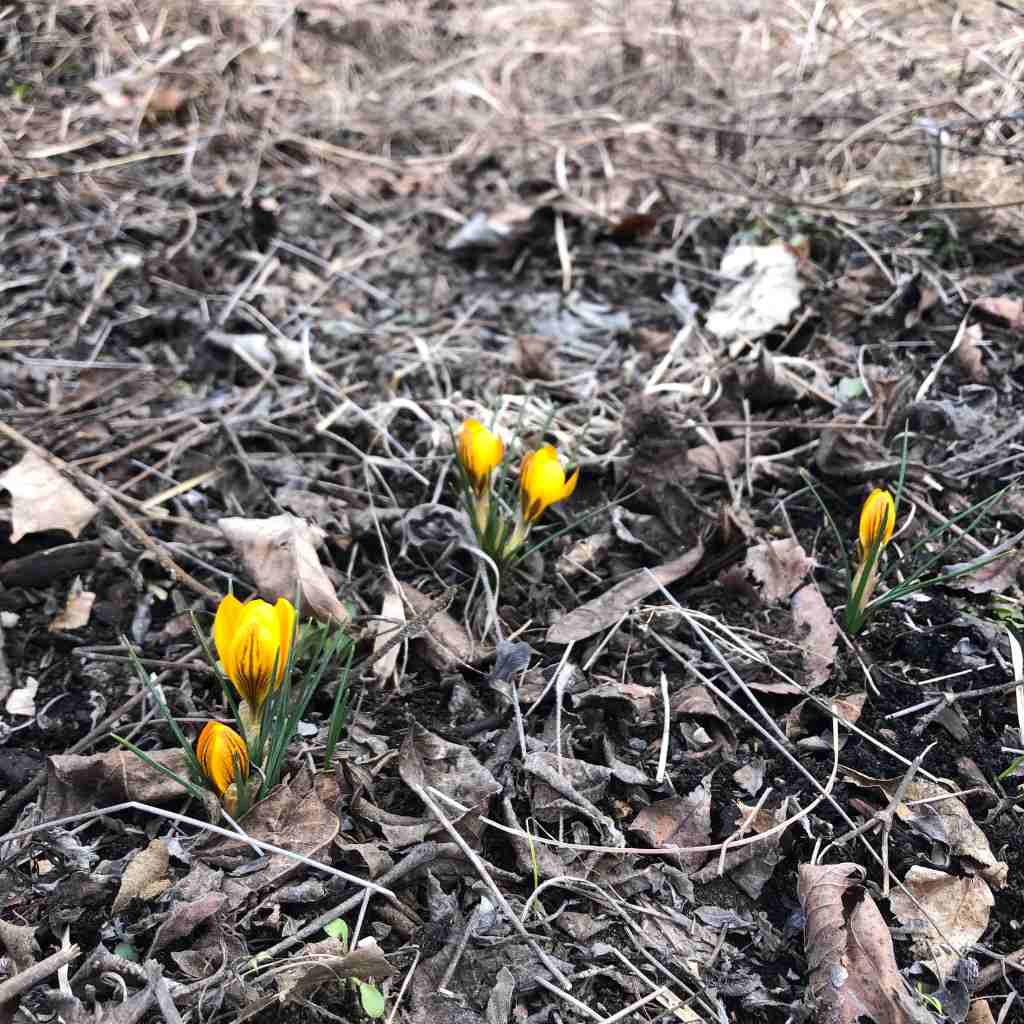
Climate patterns change each year. January here was very mild and crocuses were trying to bloom at the end of January. More of them are appearing now at the beginning of February, but usually they bloom here in early March. Crocus chrysanthus 'Goldilocks' ©US Perennials
But the trigger for writing this article was really a Facebook post: I put together comparison pictures of the freshly cut down garden and picture of the same spot in a about month time form now. I shared this post on Facebook in 3 groups (2 local Indiana groups and one herbaceous garden group USA/Canada). I got positive reactions, but I was also cautioned with several comments, that it’s way too early for cutting down the garden. That for the sake of the native pollinators, bees, and butterflies, I should wait for more stable weather with warmer days, so the insects don’t have to be harmed, can hatch, and emerge. That was not what I wanted to hear. Honestly, I wasn’t really thinking about it!
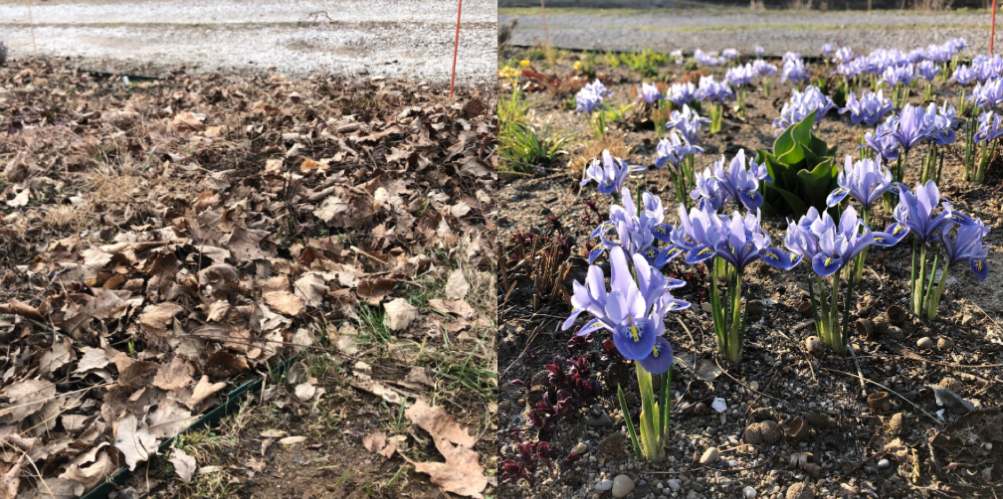
Comparison picture - the cut back garden on the beginning of February and the same spot in the first half of March. This year I left 90% or more of the debris in this sunny bed ©US Perennials
Some comments cut deeper and deeper. Despite me trying to explain, I turned red, angry and in that moment, I decided to delete all those posts. I got upset twice – for the second time because I couldn’t stay stoic, couldn’t stay above it all and let someone blame me and put some guilt on my shoulders.

Comparison pictures - garden at the beginning of February, in the middle of April and in the middle of May. ©US Perennials
The topic stayed in my head until now. But it made me read some more articles and dig a little bit deeper into it, not too deep though. That would require more time to read more articles, books and also discuss the topics with colleagues. With approaching spring, that’s not possible.
1 – DON’T CUT THE PLANTS IN THE FALL, BUT IN THE SPRING
We all kind of agree, that the best thing is to leave most of the plants and perennials standing for the whole winter. Many plants and grasses still hold some seeds for birds, they create environment for overwintering many small creatures and many plants stay pretty and provide interesting dead structures and even colors for most of the winter. The plants protect themselves too – the uncut stems will catch the leaves that the wind brings to them (=winter insulation), the plants also drop their leaves and mulch themselves and improve the soil for themselves and provide nesting or overwintering shelter for insects and other animals. If you cut plants in the fall, hollow stem can rot away much easier and you also lower the durability of some grasses and perennials.
Every rule has to have some exceptions, and some plants are recommended to be cut down in the fall for better overwintering, to prevent seeding or reducing the number of pests or diseases in the next season (for example tall Phlox, Hemerocallis, Hosta).
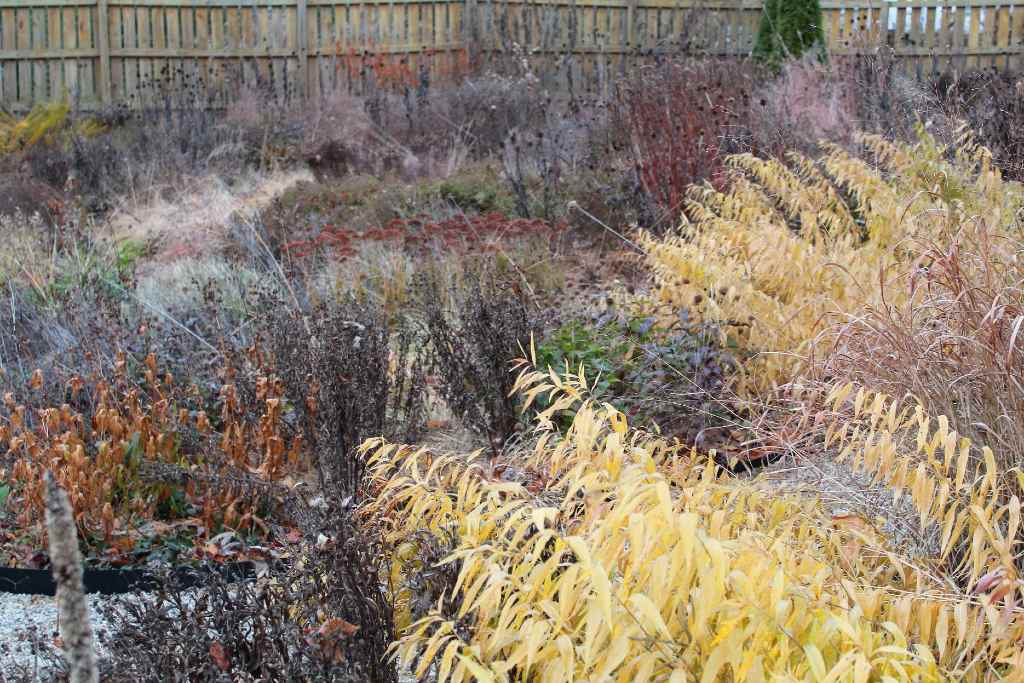
Late fall garden is very pretty.Most of the dead structures and even some color persist for the most of the winter. But the closer to spring you get, the more the colors bleach and structures will start to fall apart. At some point, you will have to cut your garden down. ©Andrew Marrs garden Design
2 – CUT THE PLANTS DOWN BEFORE NEW SPRING GROWTH EMERGES
This is the common and general horticultural practice. You simply want to remove the dead parts and stems when the plants are budding or slightly before that. Because all the new green stems are usually fragile and vulnerable. If you wait too long, the longer the stems get and the more likely you can break off the stems, future flowering stems, leaves or both. The longer you wait, the more difficult it gets to enter such a bed and you will have to hand cut most of the plants. While in the pre-spring, or early spring you can use a mower, mulching mower, weedwhacker, electric hedge trimmer - this all saves a lot of time. Especially for larger gardens and plantings, it’s nearly impossible to hand cut all the plants. With the mower you usually mow the area several times over and over from different directions, to chop the stems shorter and properly. Be careful with certain plants, like mature clumps of Sporobolus heterolepis - Prairie Dropseed (it's crown is sensitive for damage), and don't cut down evergreens. In some cases, you may still have to use pruners.
The automatized method is fast, efficient and for the landscapers, garden stewards or companies who maintain larger, several or many gardens, this may be the only option to manage everything in time.
Check the Erin Shanen - The Impatient Gardener tutorial video :
3 – DON’T CUT THE PLANTS IN THE SPRING TOO EARLY IN THE SPRING
This approach is the motto of the native plant gardener. It is the best and respectful way to protect insects and that can hibernate until the spring temperatures are more stable – reaching recommended temperatures of the 50’s of Fahrenheit (about 10 degrees of Celsius) for about 7 days in a row. Some sources refer to day temperatures, some even night temperatures. This is also usually somewhere around the time when the last spring frost appear.
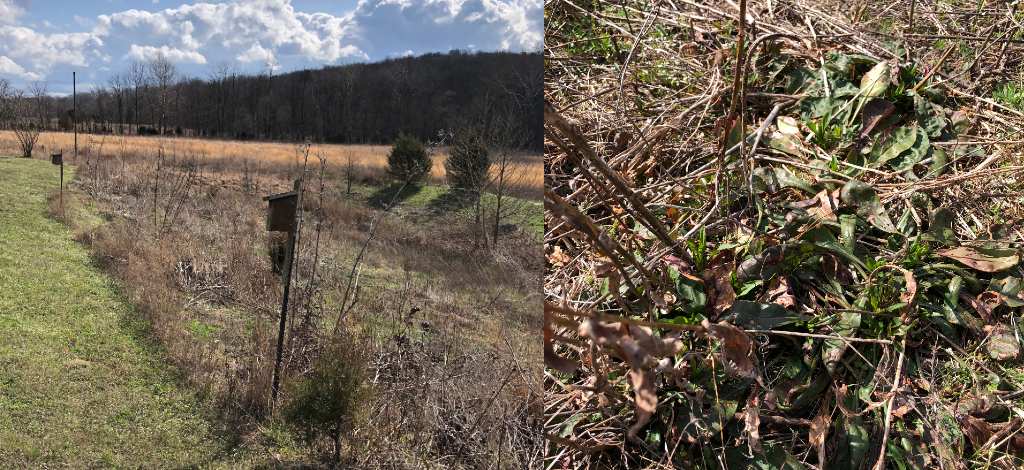
Prairie planting at Eco Logic LLC, Bloominton, IN, zone 6 on the 24th of March 2019. Tall grass prairies sleep for very long time, nearly all perennials here are still dormant. The earliest sprouting plant is the Penstemon digitalis (Foxglove Beardtongue) on the right. Later clean up here is suitable, better and recommended. ©US Perennials
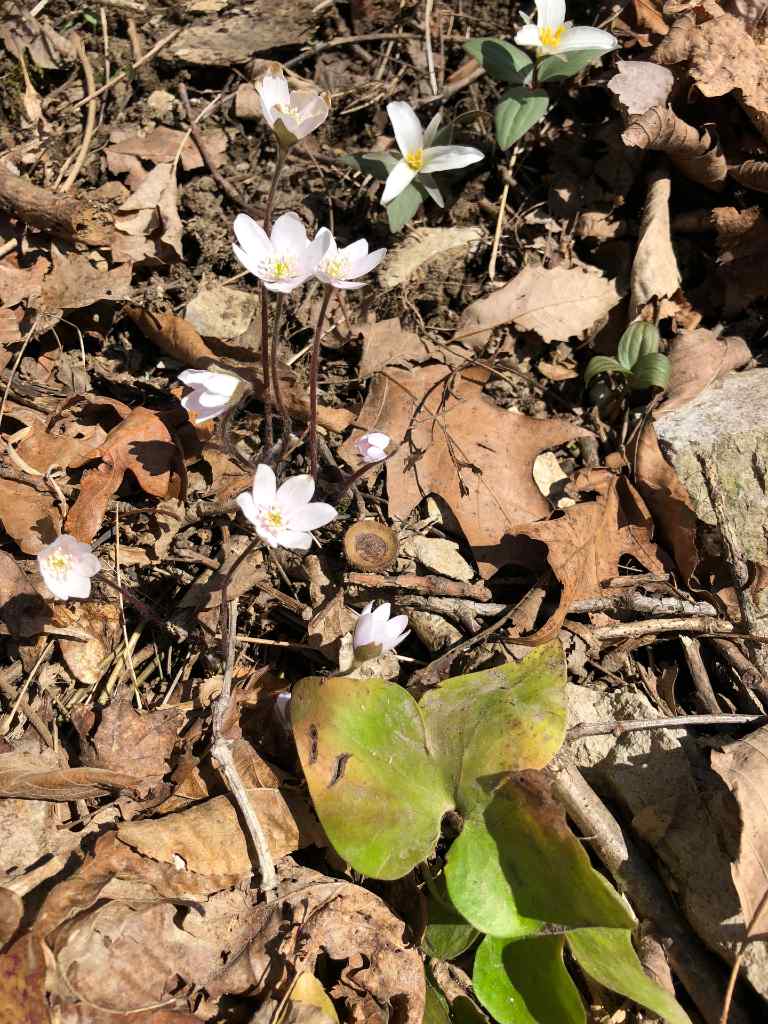
While the prairies take their time, the woods are awaking in the second half of March with Trillium nivalis (Snow Trillium) and Hepatica acutiloba (Sharp-lobed Leaf). Soon followed by row of spring ephemerals (Erigenia,Cardamine, Sanguinaria Jeffersonia, Mertensia, Claytonia, Delphinium tricorne, Trilliums and others). All of them are in the rush, they need to bloom, finish their cycle or set up the seeds before the trees will leaf out and shade them too much. ©US Perennials
For our area the last frosts happen in the end of April or early May. If you grow mostly native or warm season plants, this is really the best method. Majority native plants from sunny areas (open areas, prairies) stay dormant much longer and you can be sure you did the best what you could. Again, there are some exceptions – sandy prairie for example contains more earlier blooming plants and cool season grasses (we usually don’t have sandy-prairie gardens, but “clean up” or prescribed burn in such a places is recommended earlier).
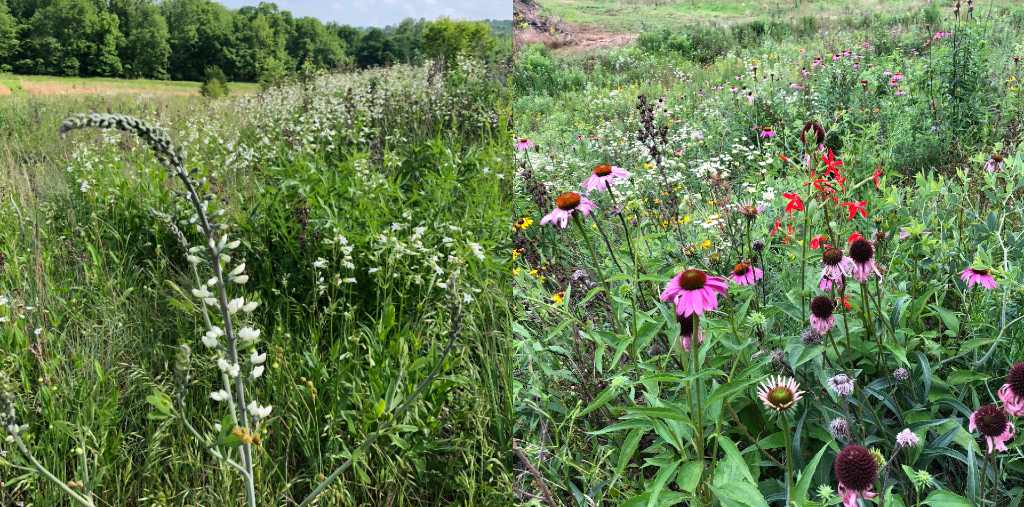
The same prairie At Eco Logic LLC, Bloomington, IN. On the left in the second half of May 2019 with dominant Penstemon digitalis (Foxglove Beardtongue) and Baptisia alba (White False Indigo). On the right - the second half of June with first flowers of Echinacea purpurea (Purple Coneflower), Silene regia (Royal Catchfly), Ratibida pinnata (Gray-headed Coneflower with yellow flowers).
For me this is the conflicting rule because I also grow bulbs and early plants. It brings the very basic questions: What plants do you grow? Why do you even garden (for wildlife, for plants, for the fun)? What are your gardening goals?
These questions in my case leads to another 4th rule.
4 – DON’T LET PERFECTION BE THE ENEMY OF THE GOOD
In my case I do garden for my passion for herbaceous plants. It’s fun, it can be a struggle and hard work too. It’s also work on your inner yourself - you have to be patient, calm and present, observe, consider, often start over, go back to improve something, and learn from it. Gardening is constant learning, full of surprises and never-ending discoveries. It is probably even lifestyle.
That is why, I do try to grow as many species and different plants as possible. I am fascinated by the endless variations and beauty of all the plants and flowers. I want to layer my garden in time and space properly.
The time layers mean I want to see and enjoy flowers, colors, and plant growth as much as possible. If the climate zone here would allow it, I’d like to have some flowers for the whole 12 months. But winter always interrupts the growing season, but I get close to my goal – after the latest fall blooms of Aster oblongifolius ‘October Skies’, Chrysopsis mariana in October and the very last Chrysanthemum flowers in October/November, the Helleborus foetidus (Stinking Hellebore) starts to bud in December! (the buds wait till spring of course, freezing temps won’t allow the blooms to develop). In January and February Helleborus niger starts to bud. With the fall leaf colors and winter structures and tones of beige, brown, gray, black or coppery, is the winter bearable. But I still can’t wait for the cheerful bulb flowers and those look better in cut back garden. Early botanic yellow Crocuses (Crocus chrysanthus ‘Goldilocks’) are usually the first ones (this year since January, but usually February/March). Very soon they will be replaced by two cultivars Iris reticulata (Reticulated Iris) in February and they’ll prepare the scene for some Galanthus (Snowdrops). In March followed by Chionodoxas (Glory of the Snow), Muscari (Grape Hyacinth), true Hyacinths, Darwin Tulips, Narcissus etc. and first perennials like Phlox bifida (Sand Phlox), Phlox subulata (Creeping Phlox) or Verbena candensis ‘Anna’s Pink’ (Rose Verbena) ….
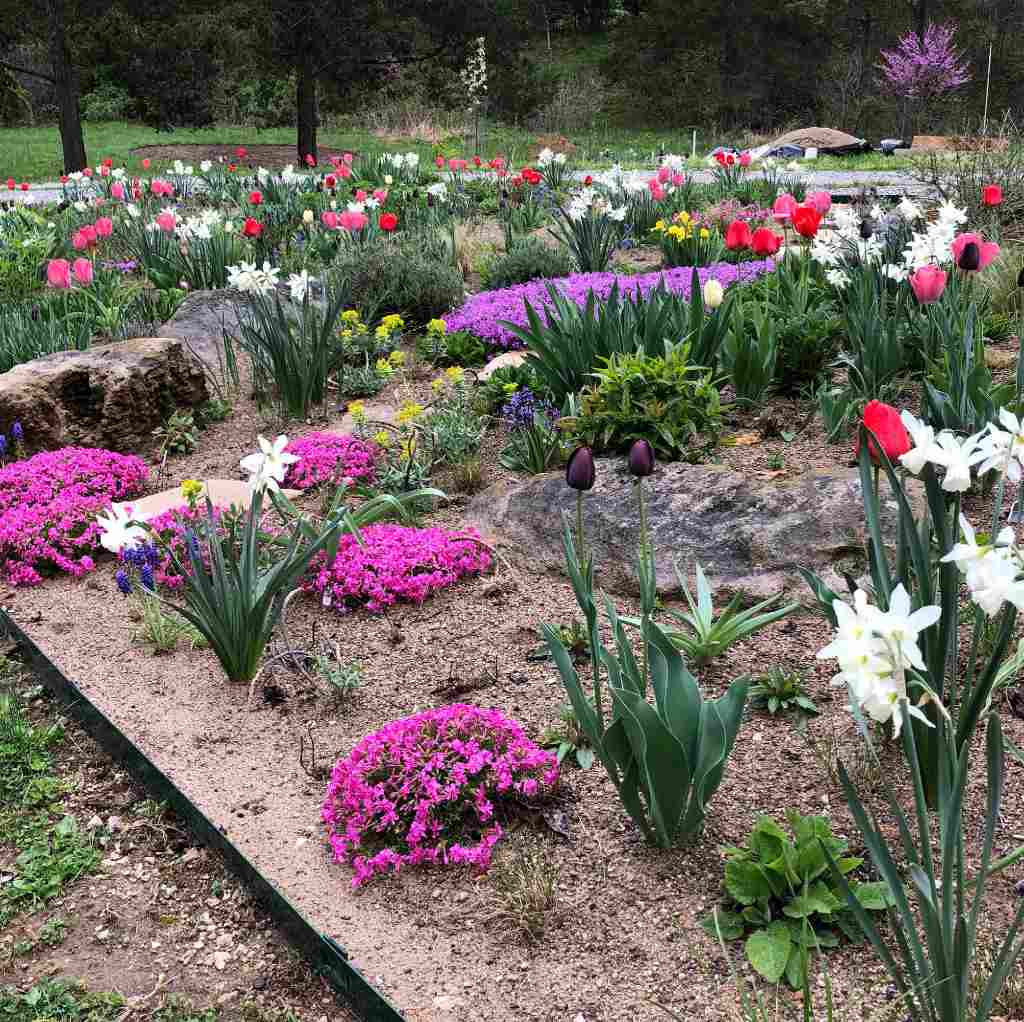
Garden in mid April 2021 is full of bulbs and early perennials - this is the second or third layer of the flowers in the spring. Notice how clean it used to be (sand surface), this year I kept most of the debris on the site. The sand kept the weeds at bay, but with the lack of organic matter, some plants after 3-4 years started to be stunted.
©US Perennials
Long story short – if you grow spring bulbs and other early sun perennials, you have to clean up your beds earlier = before the insects can emerge. If you don’t do so, you risk breaking the plants, flowers and you may not enjoy the spring show fully (small bulbs will be hiding behind uncut plants).
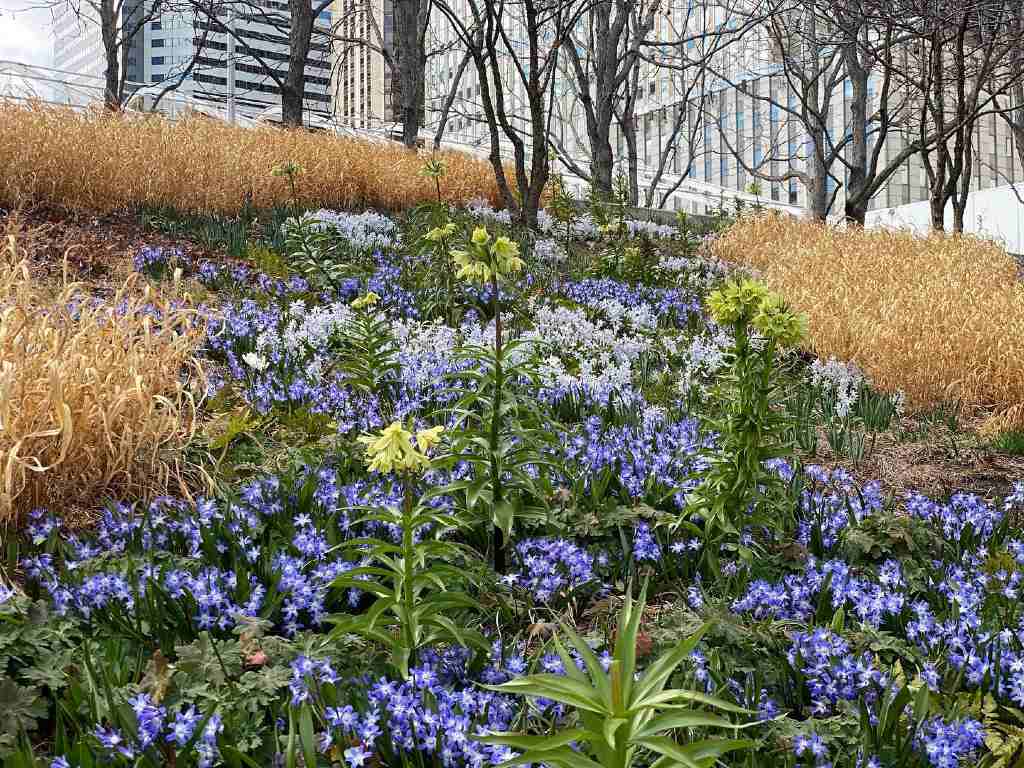
Early bulbs in Millenium Park in Chicago on the 15th of March. Puskhinia scilloides var. libanotica (Striped-Squil), Chionoxa lucilae (Star of the Snow) and tall Fritillaria raddeana in naturally contrasting combo with dead yellow leaves of Hakonechloa macra (Hakone Grass). Leaving the uncut grass here is part of smart artistic intention. Design and ©Austin Eischeid Garden Design
I never “gardened for insects”, but all the life, insects, birds were always welcome in the garden. That is why I will rototill the soil only once – when I prepare the bed. Little soil disturbance is beneficial for the soil life and insects too. I never use pesticides or synthetic fertilizers. I also don’t water the garden.
Since I do love all the perennials, I don’t segregate, if the plant comes from South Africa, China, Europe or southeastern USA...if it is the plant that can or does thrive here and is not invasive, I am happy and satisfied. I also experiment and try new things and plants. I do grow Indiana native plants too. I appreciate the spring woodland species, as well as the late blooming prairie perennials and all in between. They grow together, in fairly dense and sustainable plant community, they seed around and find their own niches.
In the bed, I counted 41 botanical species of southeastern natives, 37 cultivars of natives, all together with non-native plants, a few shrubs, and bulbs it is 175 species of different plants. That is not bad for a triangle-shaped bed of the size 25’ x 50’ x 50’. I do grow more species in the other surrounding beds too.
The natives and nativars may not be in such an abundance, they are definitely not 70% of all the plants, which would be the best for optimal wildlife support, as Doug Tallamy suggests. But still, my diverse flower bed is better than the lawn that used to be here only 4 years ago. Despite some critical voices, many non-native plants here are also very pollinator friendly. They may not support the food web that much, but at least they support some pollinators.
The bed is alive, constantly changing, evolving, interacting with the weather and climate changes bumps (longer season, too much rain, too little rain, hard freeze etc.). Natural processes of seeding and evolution are supported, and the bed seems to be sustainable.
Now back to the topic of harming, killing or disturbing overwintering insects:
Do I do really do that much damage when I cut my garden in very early spring or pre-spring?
How many insects are really disturbed and killed by my early activities?
Should I be blamed that I do gardening my way?
Should I feel guilty, that I grow non-native perennials?
How much should be a gardener responsible for insect mass extinction?
Where is the responsibility of agriculture and farmers, who decimates insects repeatedly by tons and tons of pesticides and chemicals?
If I do so much damage to insect communities (as some local gardeners say). Isn’t my gardening impact overall resoundingly positive?
Is somebody’s “absolute truth” about spring cleanup applicable into my case or other gardeners’ cases?
Who has the right to tell you how you should garden and what you should grow in your garden? How do you value aesthetics of the garden…… all these questions and more had risen up after my post on Facebook.
Generally, I try to incorporate all the views and safe gardening practices, that seem to be right and be responsible as much as I can. I compromise.
It may not be the best, but I don’t want to let perfection be the enemy of the good.
Gardening has lot more complexity than we may see on the first sight. As my friend, naturalistic garden designer Andrew Marrs says: "The world is in bad shape and how we cut our gardens isn't going to fix it. In our efforts to improve the ethics of our gardening practices, I think we have to be careful not to over exaggerate the benefits and certainly we shouldn't become self righteous about it."
5 – LEAVE THE DEBRIS ON THE SITE
I heard about this technique long time ago, but never really fully applied it. Especially in the sunny garden. I always used to clean up the gardens more than less, because it looked clean and tidy.
But with gardening in USA in completely different climate, where I failed with too many plants, I had a feeling I have to start from scratch again. Not the greatest thing, I can tell you. But soon I realized that more natural looking garden does hide plant failures and design failures than traditional flower bed. From there it's much closer to more natural techniques.
As Roy Diblik openly recommends and also successfully practices in nature there is really no one who would bring the rake and rake everything clean. The plant debris stays on the site and plant mulch themselves and grow well in their own debris. This is happening for millions of years, it’s very logical and natural. It is totally understandable in the woodland’s conditions and gardens, but the debris also stays in open sunny locations. This is the part of the natural cycle, that also improves and keeps the soil healthy and helps to keep the whole natural process running.
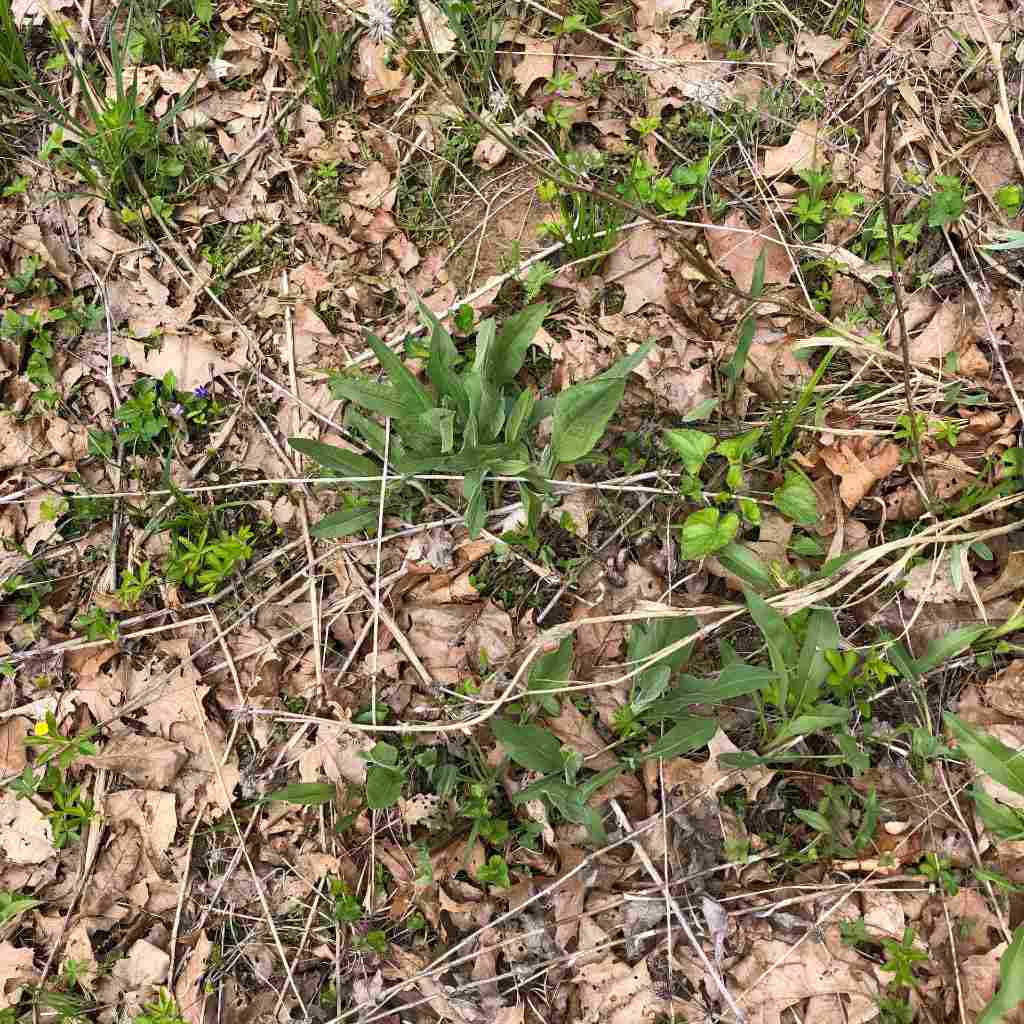
This is how nature mulches it's gardens - with leaves and debris. Plants actually mulch themselves. Sunny prairie of Phyllis Schwitzer is surrounded by deciduous woodlands, so the leaves were brought here by the wind. Bloomington, IN on the 8th of May 2020. Notice the blooms of Viola sp. and Potentilla sp.©US Perennials
Fire (in North American circumstances) is the only power that wipes the debris out from time to time – this used to happen both in sunny areas and also partially shaded areas (savannas, pine barrens). Occasional natural, manmade or prescribed fire (prescribed burns) have the same positive effect on the whole floral and faunal communities. But other than that, the debris stay on the site. The herbaceous plants will prepare the ground for woody plants and in a few hundred years, the forest will climax here.
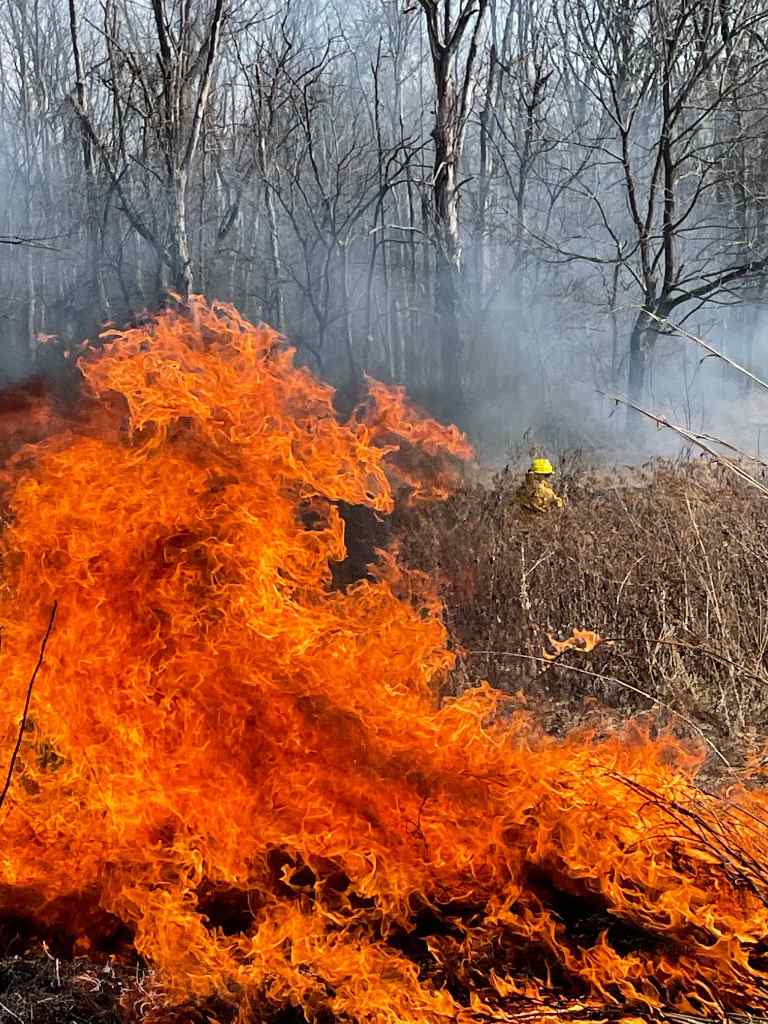
Prescribed burning of two prairies and one old field provided by Eco Logic in Paul Ruster Park in Indianapolis on the 15th of March 2021. Daily temperatures in this week were quite stable around 60 Degrees of Fahrenheit (15-18 Celsius), night temperatures between 55-35 Fahrenheit (13 to 2 Celsius). Many insects probably hatched, woke up from hibernation and managed to escape the fire. Many probably also didn't make it. But suppressing the wood samplings succession by fire, opening the ground for nesting the birds and setting the new start for biodiversity of herbaceous plant, insects and the whole ecosystem is very positive. No matter how horrific this picture may look, fire is creating and maintaining power in American landscapes for at least 20,000 years. In this case it was perfect timing, but prescribed burns can happen anytime from the late fall to May ©Eco Logic LLC, Facebook
So, disturbance is or can be positive, or needed for keeping the grasslands alive.
Leaving the debris in the garden and self-mulching the beds is new for many gardeners. But it is effective, it does work, it does save a lot of time and money and is generally very natural and positive. You don’t have to remove wheelbarrows of cut stems, deposit, or compost them or burn them.
You just cut them down and leave them there. That supports the natural nutrients cycle, and you mulch the plants at the same time. You also don’t have to bring tons of mulch for your garden.
The mowed stems do look messy at the beginning. But in the well designed and dense plant community will be hidden by the new green growth, which will become the main visual focus. Soon you won’t notice, and debris will decompose and disappear. Such a decomposed organic matter is also the best and accurate fertilizer – it will not over fertilize your plants (plants will be shorter, more sturdy, less palatable than plants those that are fertilized and/or watered).
Hereunder is a series of pictures of naturalistic garden designed and maintained by Andrew Marrs. The time progresses from early spring (probably February to early March) to late May :
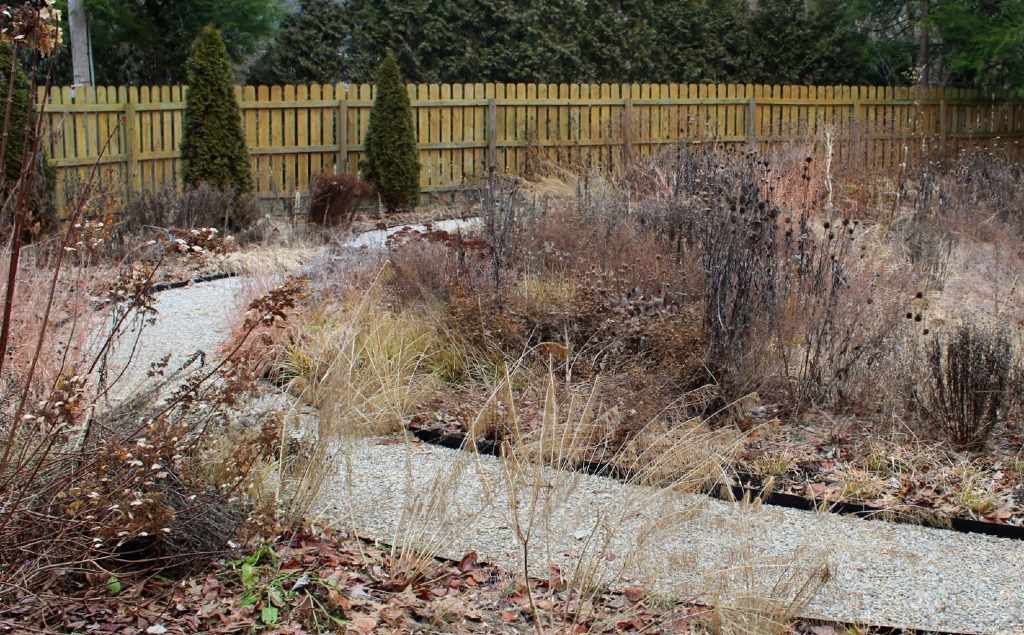
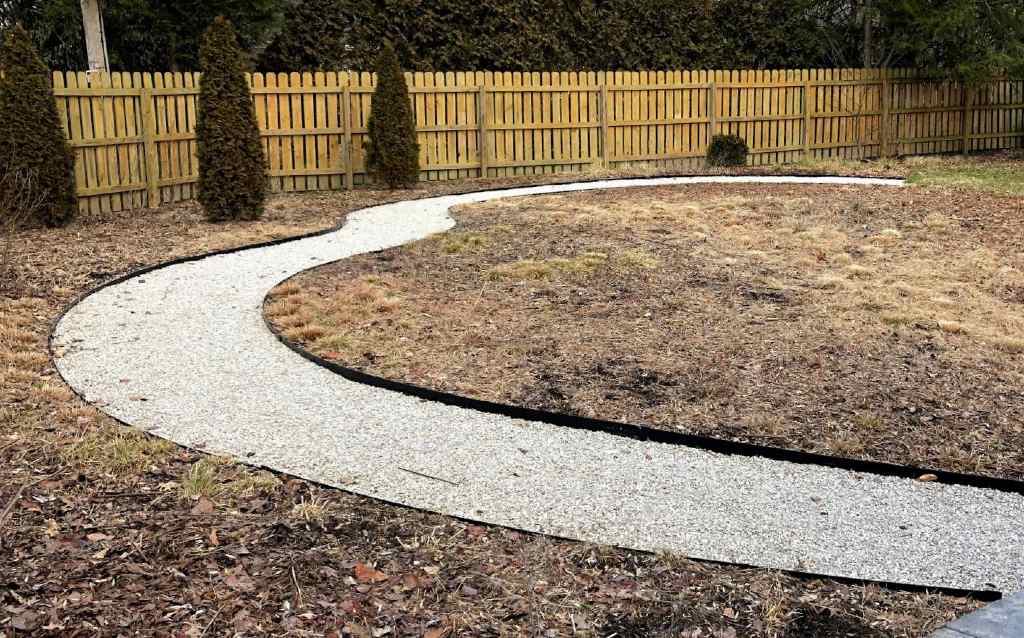
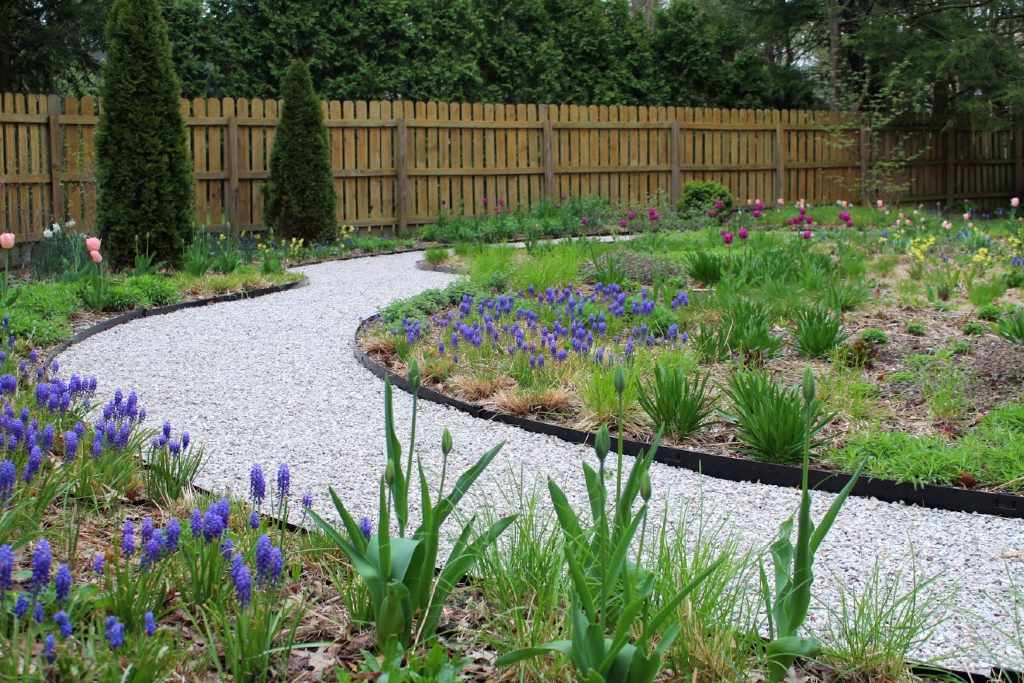
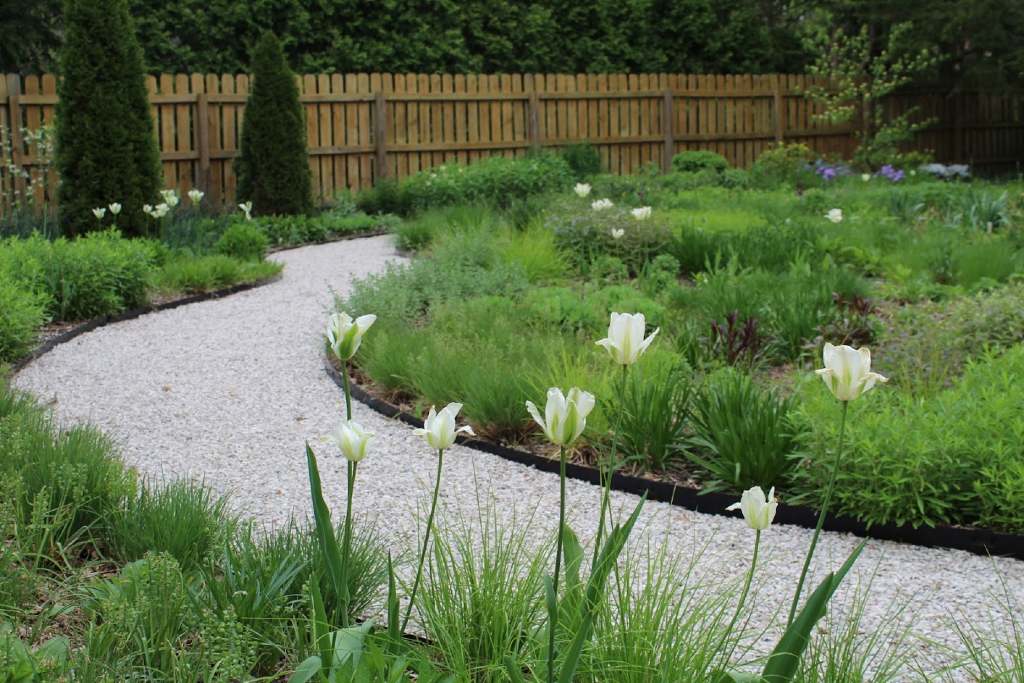
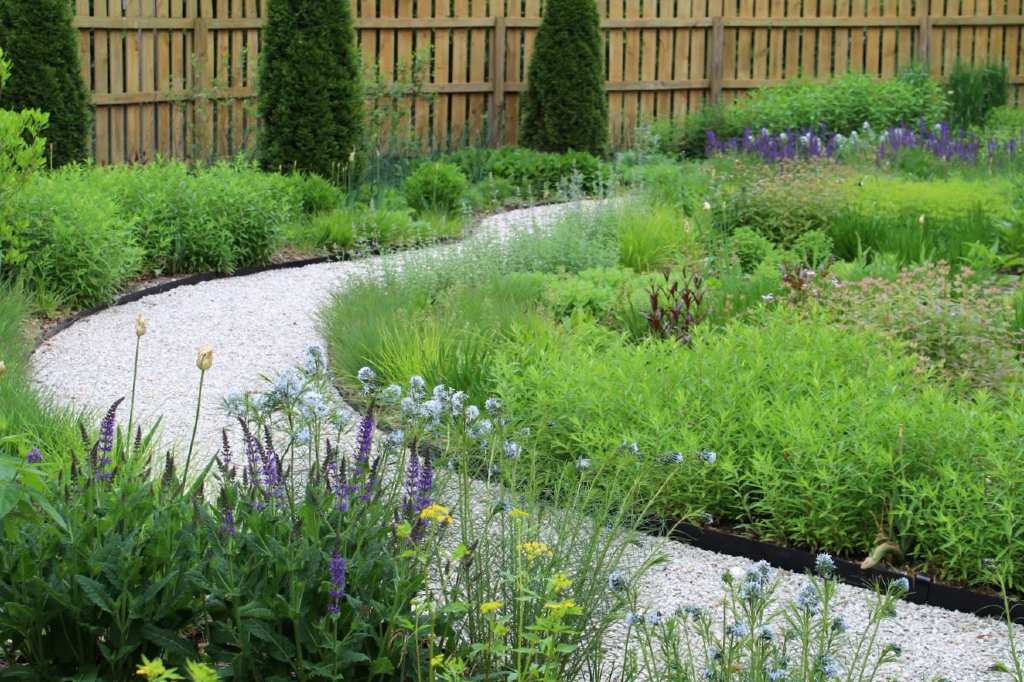
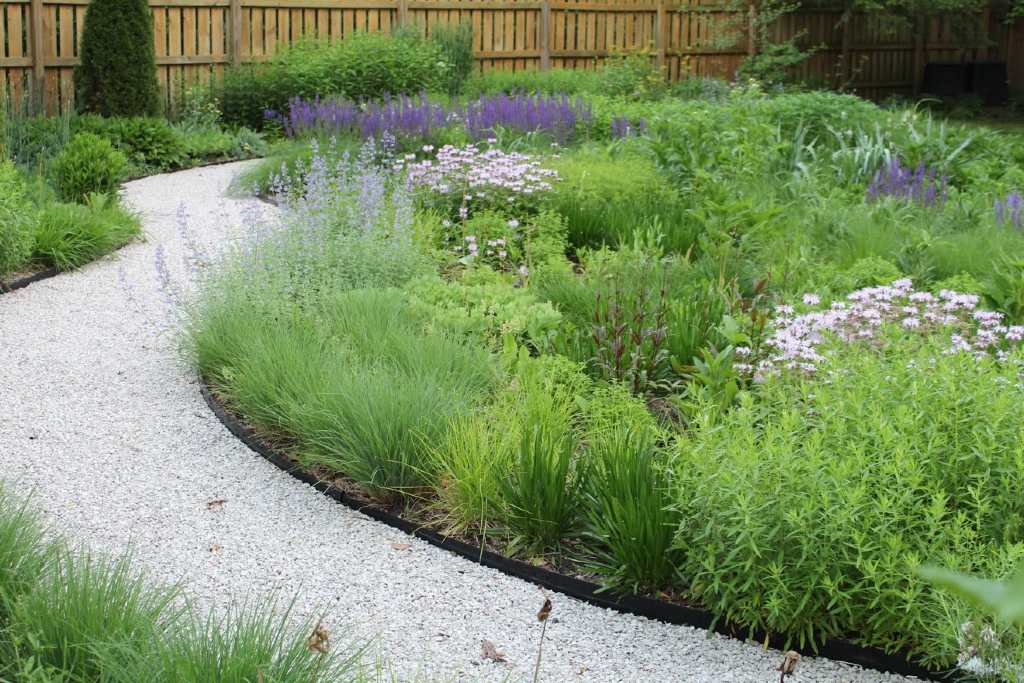
To the pics above : This garden contains mixture of native perennials and grasses, cultivars of natives, non-native perennials and bulbs. Garden was mowed down and all the debris stays in this garden. Soil is not disturbed, no chemical are used, so it is very "insect friendly" garden with healthy plant community. The non-native plants and bulbs provide the early flowers, nectar, pollen and early time layer. Most of the non-native Mint family plants (Lamiaceae, Labiateae) like Salvia nemorosa (+hybrids), Nepeta x faasenii (+ cultivars) or later on Calamintha nepeta ssp. nepeta are true pollinator magnets and can attract actually more pollinators than shorter blooming native Mint Family member Monarda bradburiana, or Amsonia (on the pics). Mixture planting with diverse and wide blooming times are more common and maybe even more accepted by the wider public.Generally there is not many medium-sized or taller native plants that would bloom in this time frame (another ones here are Zizia aurea and cultivar of Penstemon digitalis).If you stick with Indiana natives or southeastern natives, you could add blooms of Aquilegia canadensis, Baptisia, Erigeron philadelphicus,Salvia lyrata or Tradescantia). ©Andrew Marrs Garden Design
If the “messy look” is too much for you, you can clean up more the areas closer to your house, patio, or where the tidy look is required. In more distant or less important areas you can leave the cut debris. This seems to be good and acceptable solution.
Check great video from Erin - The Impatient Gardener about leaving the debris in the garden :
You can also keep some areas untouched for the insects and cut it down much later. That is good compromise, that is happening in the nature too. Because even with the prescribed burns, the fire does not burn everything equally. It does skip some more moist areas or spots with slightly different or less dense vegetation. Fire creates mosaic of less burned patches where the hibernating insect survive better and can successfully recover and repopulate.
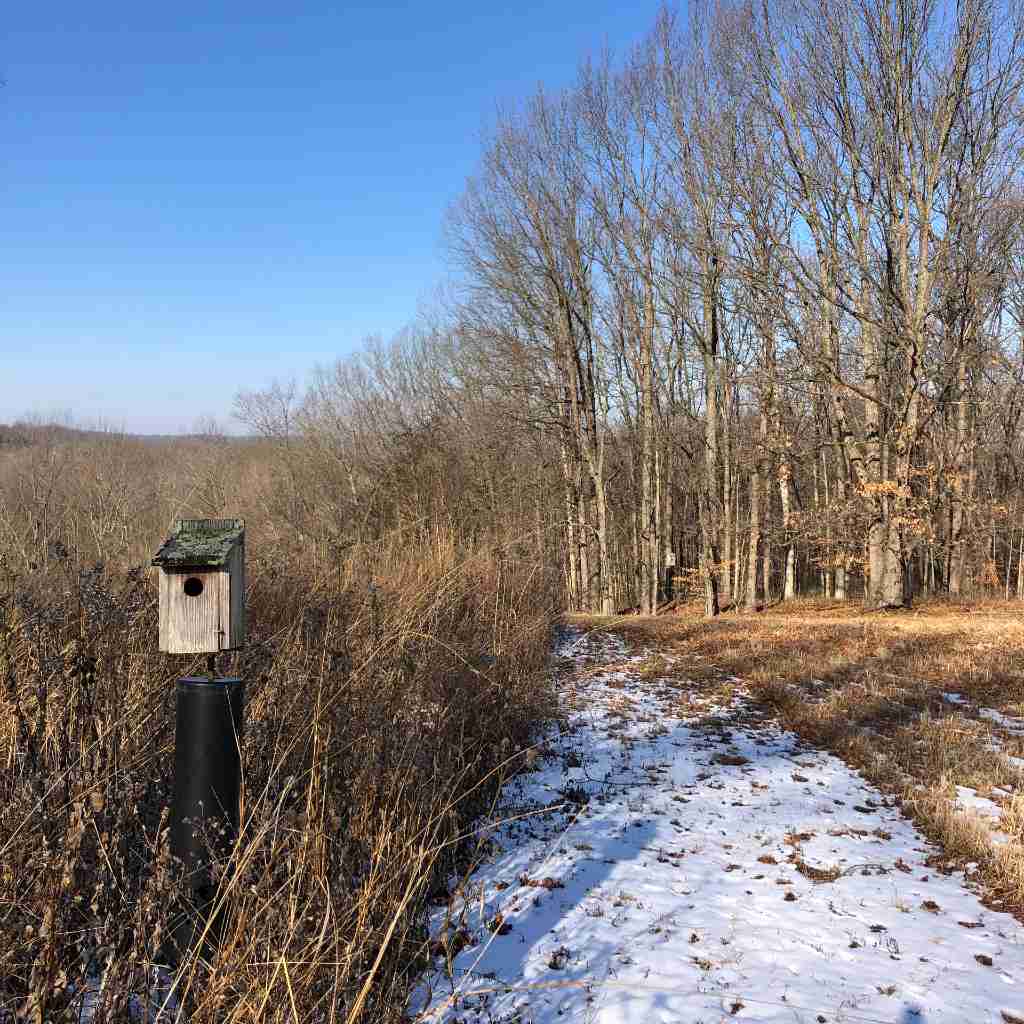
Phyllis Schwitzer (Bloomington, IN) is maintaining her prairie for nearly 3 decades. Mosaic treatment is very effective and beneficial (mowed areas, leaving the debris, keeping unmowed areas, occasional prescribed burn in certain areas, mowing the paths and changing those paths every year). Picture from early February 2021 - bigger part of the prairie was already mowed and mulched during in the fall. But due to combination of other maintenance practices in the surrounding, untouched woods and large quantity of flowering natives later on, this place is buzzing with insects from late May till October. ©US Perennials
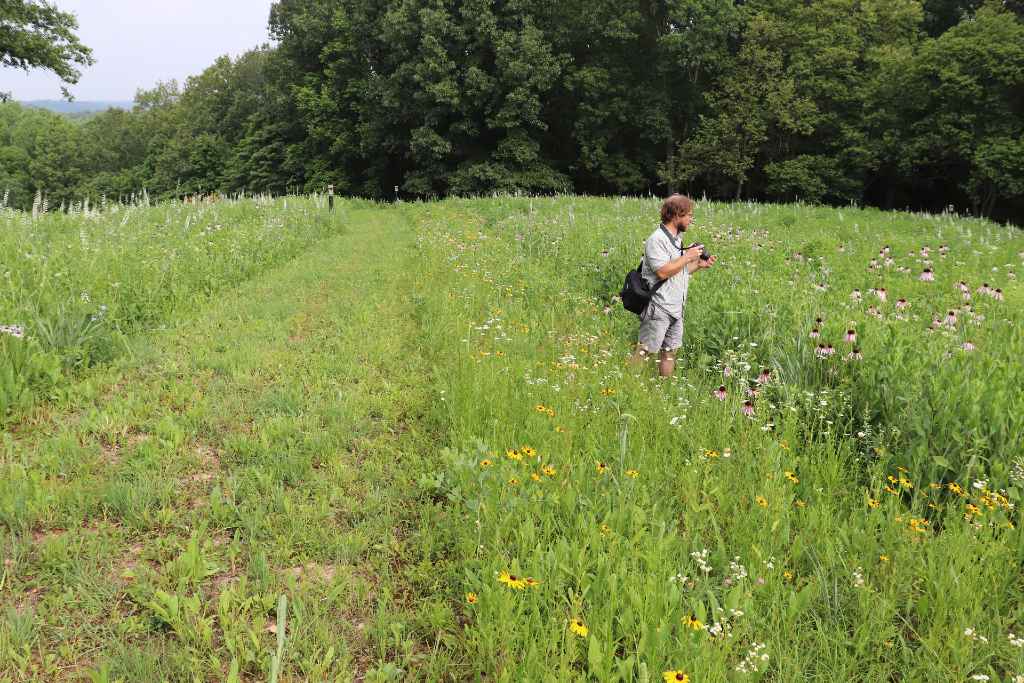
The same prairie (Phyllis Schwitzer) in mid June. Notice how the regularly mowed path from the previous year is still visible, while the new path is on the left of it. The regular mowing (different maintenance) allows other species to thrive here for a while - here it's Rudbeckia hirta (Black-Eyed Susan) or Erigeron sp. (Fleabeane). For mowing here is used heavier machinery (tractor and mulching machine). For garden scale it can be the mower. We can also successfully apply the mosaic treatment or mosaic clean up in our gardens. ©US Perennials
For those who reject the mowing the garden down with a mower. This method isn’t that bad and harmful as you may think and is probably better than weed whacking. Because you mow with the blades way above the soil level (mowing really low is impossible, it is not a turf). So you don’t disturb the lowest debris/leaf layer (where the most if the insects are) and you don’t disturb the soil. No soil disturbance is important too, because some insect hide there and 70% of native bees hibernate in the nests in the soil. Quite a few of native bees hibernate in the old wood and under the bark.
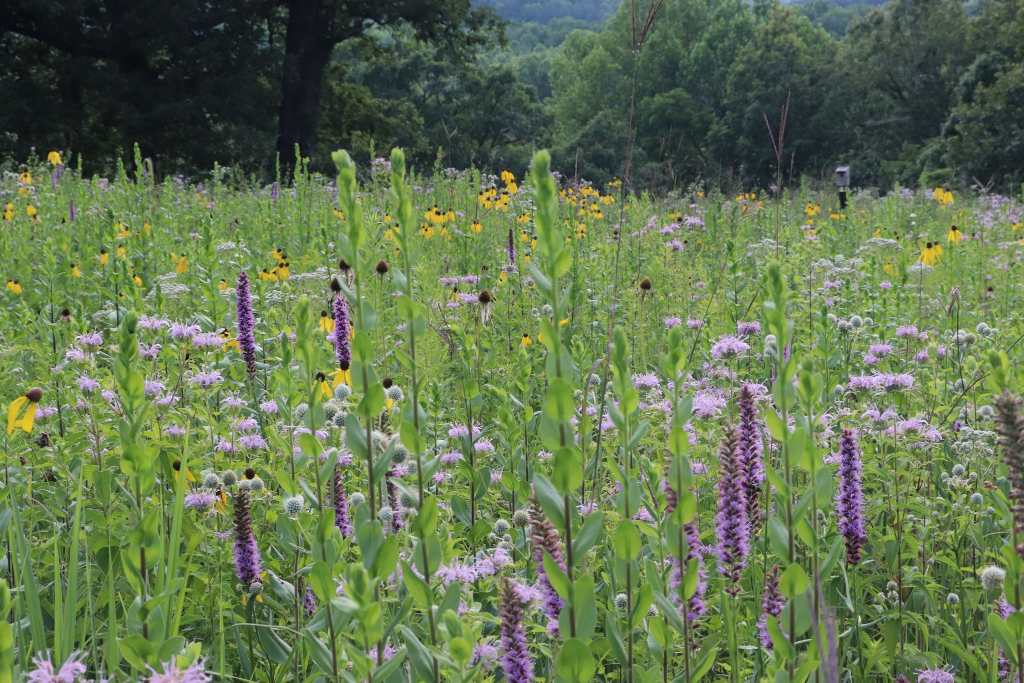
The same prairie (Phyllis Schwitzer, Bloomington, IN) in the middle of July ©US Perennials
If you garden for the wildlife and still have some early bloomers and bulbs and your garden isn’t huge, you can compromise and do little clean up around the bulbs and keep the rest for bigger cleaning later on.
6 – OTHER CIRCUMSTANCES
- Timing of the spring clean up really depends on the plant assortment in your garden, on your time schedule, scale of the gardens, your ability to get out and work, on the weather or other goals. The warm pre-spring days here usually bring lots of rain for example. Soil gets too saturated, and you have to work around it.
- If you want to support wildlife and insects, you can still do deeper clean up in some parts and even cut some areas early. But keep some surrounding areas less touched, untouched or debris mulched! This spring I had to remove most of all the debris and leaves from 2 beds, because the voles got in there and were decimating a lot of plants. These beds are fairly small, but very close to wild and not mowed areas). The method of mosaic treatment is the most natural way and is used in bigger scale in prairie or natural habitat restorations (but works well in smaller garden areas too). So, with keeping some proportional untouched areas, you can do the prescribed burns or clean ups even in the winter, very early spring or even in the fall. The flexible timing of prescribed burns in restoration also comes from the impact that you need to achieve there (reduce unwanted woody vegetation or invasive species, cool season species etc.). If there are no serious troubles, the best prescribed burn term is May.
- In gravel mulched beds or sand beds (= where the growing medium is the sand itself), you clean up all the debris at the end of the winter, or pre-spring. The plant community there contains all plant forms including the bulbs and early flowering perennials. Any organic matter is immediately removed after being cut down, because enriching the soil or growing medium is unwanted – the gravel filled with debris will stop working, allowing the weeds to invade such a bed. Plus in both cases the leaner soil is desired - poorer soil is desired to support higher diversity of plants. In rich soil the competitive perennials or grasses grow too aggressively and will push away weaker growing species. Higher plant diversity also means higher insect diversity.
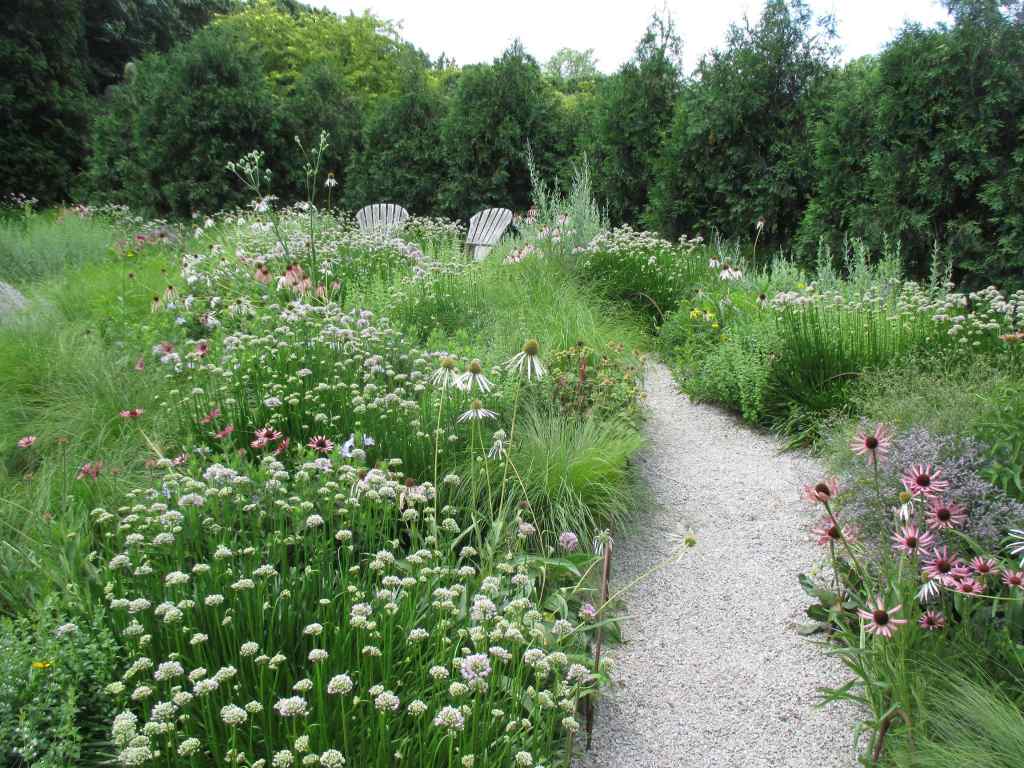 Gravel Garden at Olbrich Botanical Gardens (Madison, Wisconsin) - the cut stems in gravel beds are usually raked away immediately in the spring, so the gravel doesn't fill with the organic matter and continues working as the weed barrier. The site stays leaner, which is preferred by some plants. ©Mark Dwyer, Landscape Prescriptions
Gravel Garden at Olbrich Botanical Gardens (Madison, Wisconsin) - the cut stems in gravel beds are usually raked away immediately in the spring, so the gravel doesn't fill with the organic matter and continues working as the weed barrier. The site stays leaner, which is preferred by some plants. ©Mark Dwyer, Landscape Prescriptions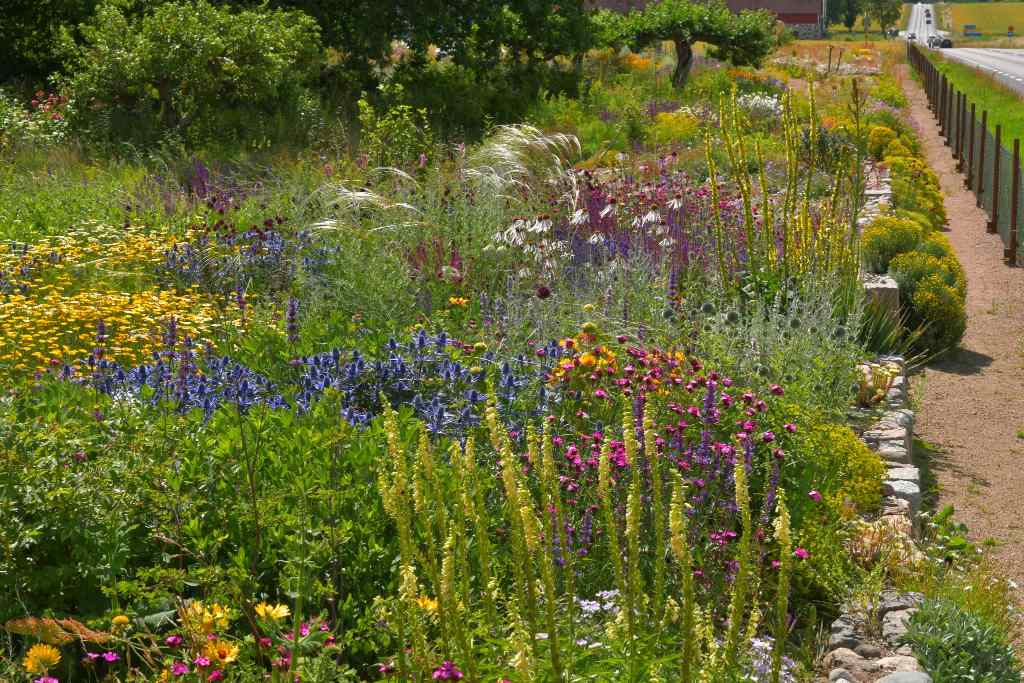
- Peter Korn's sand gardens in Klinta (Sweden) are another exception where any debris is taken away in the spring (in some areas could be even burned). The lean mineral growing media (1' tall layer of pure coarse sand with thin layer of river rock on the top) is the key for high diversity and keeping more aggressive growers in the bay ©Peter Korn
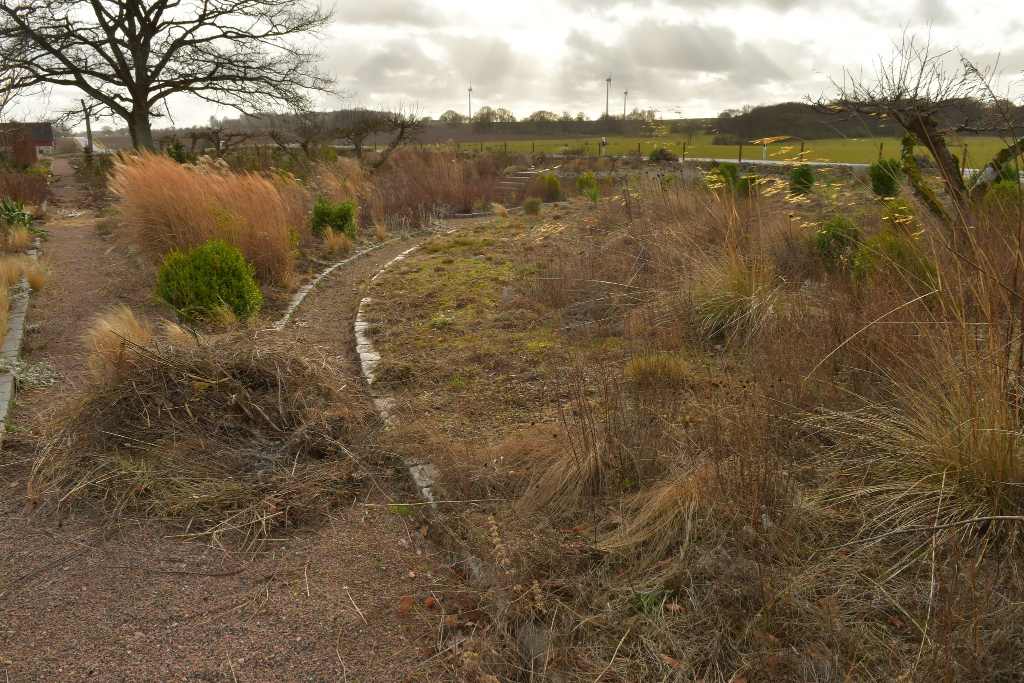
- Peter Korn about the spring clean up (02/18/2023, Facebook) : "Spring has speeded up the last week and now it´s time to cut everything down before the bulbs has grown too much. After the cutting I blow all the beds to get rid of all organic material. I want to keep the beds as clean as possible and reduce the nutrients. We put all the material on the compost before we use it in the kitchen garden or in the woodland part of the garden."
- Maybe the last additional words could come from Benjamin Vogt, author of newly released book "Prairie Up" : "I don't cut down some areas at all. As you say, it depends on lots of things. However, if you cut it all down to a moonscape you've taken away nesting material for the 25% of native bees that nest in cavities. When I leave Zizia aurea stems at 12" they are INSANE with activity from little ceratina bees. Echinacea sees action. Asclepias. Coreopsis tripteris a ton too (ceratina again in May). New growth quickly covers and hides these stems. It sure is a topic that is surprisingly heated -- not sure why. Maybe because it isn't easily black and white and complicates things." (Facebook)

